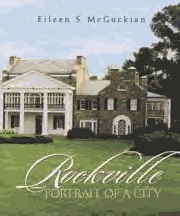
Rockville, Portrait of a City.
Hillsboro Press, Franklin, Tennessee, 2001.
Chapter 4, pp. 51-53.
© City of Rockville
Local Historian
Account
An account by local historian, Eileen McGuckian.
 |
McGuckian, Eileen S. Rockville, Portrait of a City. Hillsboro Press, Franklin, Tennessee, 2001. Chapter 4, pp. 51-53. © City of Rockville |
Fighting in Rockville
In July 1864, the Confederates made their only attack on Washington of the war. On July 9, Confederate Gen. Jubal Early defeated a Union force along the Monocacy River in Frederick County and continued south on the main road to Washington, D.C. Most of the Federal army was engaged in heavy fighting around Richmond and Petersburg, so Washington was then held by a ragged collection of convalescents, government clerks, home guards, draftees, militia and stragglers.
In a race to the capital city, Early sent Gen. John McCausland´s cavalry down the Frederick Road. A hastily assembled Union force under the command of Maj. William Fry met McCausland two miles north of Rockville, at a hill near present-day Gude Drive. Major Fry, trying to buy time for Washington, formed up in two lines, one a mile above Rockville, the other on Commerce Lane. Using information from a Southern sympathizer, the Confederates charged the small Union force, breaking both lines, and a spirited battle ensued while Fry´s unit reformed at a hill near present-day Edmonston Drive for a last stand. When McCausland added artillery to his attack, the Federals melted into the woods farther south on the Pike.
McCausland ate dinner at the Montgomery House Hotel across from the courthouse, while his men camped on the fairgrounds. Just after dawn the next morning, July 11, Early arrived in Rockville with eight thousand infantry, forty pieces of artillery, and two cavalry brigades. A reporter noted that "the streets were blockaded with passing infantry, artillery and wagon trains. Nearly every regiment was headed by a band of music, which, generally, as they marched through the town, discoursed fine music." Depending on their loyalties, the locals cheered the soldiers or kept out of sight.
Leaving guards at Rockville, Early sent McCausland down the Pike to Fort Reno in Tennallytown (now Tenleytown) while he led a larger group past Sam Vier´s mill and on toward Washington. After testing the capital´s defenses at Fort Stevens, taking a shot at President Lincoln, losing more than two thousand men, and assessing Union reinforcements, Early fell back into Maryland on July 12.
By Wednesday morning, July 13, General Early and his generals were back at the Montgomery House in Rockville. Depressed over his failed plans, he contented himself with having "scared Abe Lincoln like hell." He sat for an hour on the long piazza of the hotel studying his map. As the morning grew warm, Early mounted up and rode west with his men. The Confederates set up a defensive line along Watts Branch a mile out of town on the Darnestown Road, then headed accross the river and home without a victory in Washington.
Union Col. Charles Lowell watched from high ground near Saint Mary´s, then moved his eight hundred cavalrymen through Rockville behind the Confederates. He watched the superior rebel force withdraw, sat down at the Montgomery House to write a report to Washington, and sent a small force to monitor the rebel movements. But Early, annoyed that the Federals had retaken Rockville, ordered Gen. Bradley Johnson and his all-Maryland cavalry to drive them back. As some of Lowell´s men prepared to charge, Johnson attacked and drove the Union forces eastward through Julius West´s pastures and back into the center of Rockville.
For two hours Rockville´s streets, yards, alleys, gardens and buildings were the scene of hot, close, confused combat. General Johnson wrote that the "dust was so thick" that men could not see the houses in front of them. In the fighting Union Pvt. James Hill, from California, was wounded near the grounds of the Beall sisters´ house, taken in by them, and nursed back to health.
Lowell dropped his pen when he heard the sounds of battle on Commerce Lane. He positioned his men on rooftops, behind trees, and along the triangle on front of the courthouse. When the Rebels rushed down the hill, the Yankees fired short-range volleys at them. Hours later, the outnumbered Union troops fell back to Saint Mary´s, then to what is now Woodmont Country Club on the Rockville Pike. Johnson moved back into Rockville, leaving about thirty men to hold the town while he withdrew toward the Potomac.
Both sides suffered casualties, exhaustion, deaths, and captures. Ambulances from Washington picked up perhaps a hundred men around the town and brought them to the courthouse. There they stayed for a day or two before being transferred to hospitals in Washington.